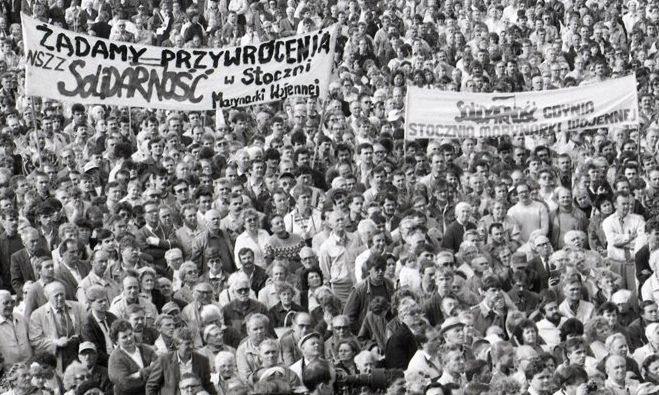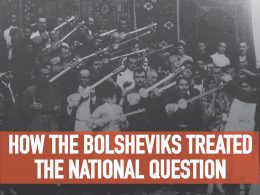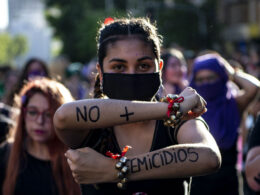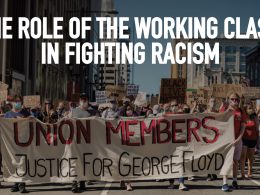Revolutionary movement with counter-revolutionary consequences
Rob Jones – Sotsialisticheskaya Alternativa ( sister organisation of the Socialist Party in Russia)
This article is the first in a series to commemorate the events of 1989
In Poland, on the 13th September 1989, the ‘Solidarnosc’ trade union, after winning an overwhelming majority in an election, formed the first ‘non-communist’ government in the former Soviet bloc since 1948. Two months later the Berlin Wall was pulled down. The spectacular events of 1989 in Eastern Europe, at least at the time, inspired the working class of the whole world even though the year ended with the execution by firing squad of the hated dictator of Romania, Nicolae Ceauşescu and his wife Elena, televised across the world on Christmas Day.
Within just two years, the former East Germany was taken over by the West, Yugoslavia broke up and after the failed hard line coup d’etat in August 1991, the Soviet Union collapsed. Capitalism was being restored across the region. The Cold War ended as the ‘Warsaw Pact’, the military bloc set up to oppose American imperialism was disbanded. The bourgeois philosopher, Francis Fukuyama, announced the ‘end of history’.
Post 1989 disaster
The mass movements were driven by the hope, that by getting rid of the abhorrent bureaucratic dictatorships that ruled the Soviet bloc, life would be dramatically improved. Yet the region spent the next decade in a horrific economic depression, worse than the 1930s, as the formerly centrally planned economies were replaced by free market chaos, with features more usually found in the developing world. Even the World Bank, one of the main architects of the transition reported that, by 2000, there was a 15% decline in GDP in Central and Eastern Europe and a 40% collapse in the former USSR. The number living in absolute poverty grew from 4% to 20%.
For the first time since 1945, wars between nations broke out in Europe and Central Asia. Brutal ethnic conflicts took the lives of an estimated 140,000 people and left 4 million displaced as the imperialist powers and the new national elites fought over the wreckage of the former Yugoslavia. At least 150,000 died in the two Russia-Chechen wars and another 60,000 in the Tadjik civil war. The conflicts in Moldova, Georgia, between Armenia and Azerbaijan and in East Ukraine remain unresolved.
First signs of Soviet discontent
The former Stalinist states were authoritarian regimes with large scale surveillance and repression of opponents. Often, the first signs of discontent in the Soviet Union followed accidental events or secondary issues. The explosion and fire at the Chernobyl nuclear power station in 1986 heightened concerns over the environment. In the three Baltic states, whose incorporation into the USSR as part of the Hitler-Stalin pact in 1939 had left a very bitter legacy, nationalist protests initially developed on environmental issues – in Estonia, over plans to begin phosphate mining, in Latvia, against the building of a huge hydro-electric station. People started to sing ‘patriotic’ songs after official music festivals. Elsewhere, the notorious shortages of food and other household products fuelled discontent. In the Caucasian republics, an earthquake which left 50,000 dead in an area near to an atomic power station revealed a lack of medical facilities and badly built housing. This led to a massive escalation of nationalist sentiments and the start of the Nagorno-Karabakh war.
East European experience
But in the rest of Eastern Europe, protests in the late 1980s built on earlier experiences of opposition to Stalinist rule. In the former GDR (East Germany) in 1953 and then Hungary in 1956 the working class took part in insurrectionary general strikes to demand the withdrawal of Soviet troops and free elections, whilst maintaining the socialist ownership of industry but run by workers’ councils with free trade unions, the right to strike and assembly, freedom of the press and religion, and so on.
These demands, basic requirements in a democratic workers’ republic were unacceptable to Moscow. Both these 1950s uprisings were brutally put down by Soviet tanks. Workers were left bitterly angry, whilst the Soviet system was discredited internationally. Communist party members became known as ‘tankies’.
The roots of Stalinism
The actions of the then Soviet leadership created by Stalin, who died in 1952 and his successor, the so-called reformer Khrushchev, were far removed from the ideals of Lenin, Trotsky and the Bolsheviks in 1917. The Russian revolution was intended to establish a genuine democratic and socialist society in which the wealth and resources of the country were taken into public ownership with production and distribution planned by elected workers’ committees. The Bolsheviks were internationalists, guaranteeing the right of self-determination to the nations of the former Russian empire whilst arguing for a voluntary federation of socialist states. The Bolsheviks were convinced that the new workers’ republic could only survive and move towards socialism if revolution developed in the more advanced countries.
Unfortunately, the revolutionary wave that ended the war and saw the overthrow of the German monarchy, Soviet republics formed in Hungary and Bavaria and soviets formed in Austria and Czechoslovakia failed. The new Russian republic was invaded by 15 imperialist armies and they, assisting the reactionary white-guard movement, wreaked havoc. Many of the best workers were drawn into the fighting and perished. Others had to leave the factories to manage the new state. Revolutionary Russia ended the civil war exhausted, devastated and isolated.
A layer of bureaucrats, many of whom had opposed the revolution developed and, in the absence of international revolution, strengthened, found a leader in Joseph Stalin and seized political power from the working class. It consolidated its power through a new civil war using mass arrests, terror and executions against the old Bolsheviks overturning their internationalism and replacing it with the ideology ‘socialism in one country’. In effect this was a political counter-revolution which left a bureaucratic state apparatus reflecting large elements of tsarist and even capitalist society overseeing the nationalised, planned economy. As Trotsky explained, to restore genuine Soviet democracy required not a social revolution to change the economic basis of society but a political revolution to overthrow the bureaucracy.
Stalinism extends to Eastern Europe
Due to the planned economy and determination of the Soviet people and despite the incompetence of the Stalinist bureaucracy, the USSR came out of the war victorious. Eastern Europe, including part of Germany was controlled by the Soviet army. As it advanced, the old bourgeois states collapsed and, in Czechoslovakia and elsewhere, a nascent revolutionary movement developed. Initially Stalin intended to maintain capitalism in the region with puppet governments as a buffer between East and West. But this position proved unviable. Fearing the development of independent socialist republics would undermine the rule of the bureaucracy in the USSR, the Soviet army disbanded independent action by workers and insurgents. The bureaucratically planned economy was extended across the region. Whereas the Russian revolution degenerated, in Eastern Europe the new regimes were deformed from the very beginning.
Although the planned economy suffered from terrible bureaucratic mismanagement and waste, for a period it still proved more efficient than the market economy of the West. In the Soviet Union itself, the economy forged ahead. By the 1970s, living standards almost reached western levels. In the war-devastated economies of Eastern Europe, per capita growth in the twenty years after the war was approximately 2.4 times higher than in Europe as a whole.
This, to a large degree, explains why in the GDR and Hungary, where workers remembered the reality of the pre-war fascist regimes, the uprisings did not take a markedly anti-socialist character – the dominant demands were for the withdrawal of the Soviet army and for workers’ democracy to end bureaucratic rule.
When Stalin came to power, the bureaucracy numbered a few hundred thousand. By the 1980s it had become a 20-million strong all-consuming monster. Without workers’ democracy to manage and control the economy, the bureaucracy creamed off part of society’s wealth through theft and bribery, and their bureaucratic mismanagement wasted up to 30% of industrial and agricultural production. You could not even get buried without a bribe. At their head a smaller elite, whose horribly affluent lifestyle was exemplified by Brezhnev’s huge collection of luxury cars.
The Prague spring
In Eastern Europe the situation was more difficult. The Stalinists demanded these countries paid huge reparations for the war damage inflicted on Soviet territory. Imbalances developed as the Soviet regime placed great emphasis on developing heavy industry, particularly in the defence sector at the expense of consumer goods.
These imbalances hit Czechoslovakia particularly hard, which before the war had a relatively developed industrial economy. In 1953 the Kremlin ordered a currency devaluation which cut living standards by 11%. The economy struggled to grow over the next decade. When Alexander Dubcek became head of the Czech Communist Party in 1968, he launched a programme to liberalise the economy and introduce limited democratic rights – “socialism with a human face.” During the Prague Spring of 1968, his moves to open up society gained a mass echo.
At first, the Kremlin attempted to persuade Dubcek to back down, but by August, pressurised by the neighbouring Stalinist states, who feared the protests would spread, the Prague spring was crushed under the tracks of Soviet bloc tanks.
‘Solidarnosc’
In neighbouring Poland however, another process was developing. In December 1970, the ruling bureaucracy was shaken when workers in Gdynia struck against rising prices. Dozens, if not hundreds, were massacred by the army. A new “reformer” Premier Gierek was appointed who accepted large amounts of Western credit. State debt mushroomed and dramatic food price increases made life difficult for Poland’s working class. In 1976, labour discontent was again put down by force. But underground, opposition circles were forming a new independent trade union. When, in 1980, strikes broke out at the iconic Lenin shipyard in Gdansk, the trade union ‘Solidarnosc’ was founded. By 1981 it had organized a successful 4-hour general strike involving 14 million workers including many rank and file communists. Inter-factory committees were set up – soviets in all but name. The regime was left hanging by a thread and could only save itself by, in December, declaring martial law and subjecting the working class to widespread repression.
‘Solidarnosc’ was formed to organize workers against price rises, for proper wages and against repression and, to a large degree, against the Stalinist bureaucracy in Poland. Fuelled by Poland’s long history under Tsarist rule and reinforced by Stalinist repression, ‘Solidarnosc” also campaigned against the Soviet presence in Poland. Many workers were looking in the direction of a political revolution. But the influence of intellectuals around the ‘KOR’ group and increasingly the catholic church, particularly on Lech Walesa, the Gdansk shipyard worker who became world famous as leader of ‘Solidarnosc’, led the union not just in an anti-stalinist direction but increasingly against socialism in principle.
This was not inevitable. At the first Congress of ‘Solidarnosc’ held before martial law, the leadership positioned the union as an instrument to negotiate concessions from the government. It even proposed that members work voluntarily on Saturdays to help the country out of its economic crisis. However, a radical minority, maybe 40% of delegates, argued that “genuine workers’ self-management will be the basis for a self-governing republic…. the creation of genuine workers’ self-management councils, which would make each workforce into an authentic manager of the enterprise [is the way out of the crisis]’. This was included in the ‘Solidarnosc’ programme.
Mistaken position
Although demonstrating a more radical path, self-management presented in the way they suggested, opened the way to enterprises becoming economically independent and subject to market forces, which would have eventually, as seen in Yugoslavia, become a major factor leading to capitalist restoration. Nor did the radicals present any programme for removing the Stalinist bureaucracy that ruled Poland.
General Jaruzelski, who declared martial law, later claimed that the Kremlin had refused to help him, and implied that the US approved his take-over. His difficulty was that pressures to change were building up in the USSR. After Brezhnev’s death, Yuri Andropov took over. He had led the suppression of the Hungarian uprising and also headed the KGB. He had concluded that change was needed if the Soviet bureaucracy was to maintain its rule. His short rule, followed by the even shorter term of the elderly Viktor Chernenko paved the way, in 1985, for the appointment of Mikhail Gorbachev to head the USSR.
With the hard-liners in retreat within the USSR, Jaruzelski couldn’t risk provoking an open uprising against his authoritarian rule. He started a dialogue with ‘Solidarnosc’ which as time passed saw the radicals isolated and the union adopt an openly pro-market, pro-capitalist position. A dramatic turning point occurred in November 1988 when Margaret Thatcher visited Gdansk, meeting first with the Communist leadership and then with ‘Solidarnosc’. Just ten months later, after round table negotiations, a multi-party election in Poland was held, which ‘Solidarnosc’ won overwhelmingly.
Roots of ethnic conflict
A different crisis was unfolding in Yugoslavia. Since clashing with Stalin in 1948, Josip Tito had maintained bureaucratic rule, but with a certain independence from Moscow. Tito, using his authority as partisan leader during the Second World War managed to maintain a balance between the seven diverse nations in Yugoslavia. This was possible, in part, because the Yugoslav economy was developing. By his death in 1980 however, his model of ‘market socialism’ based on ‘self-management’ was experiencing a mushrooming foreign debt and a 20% unemployment rate. This opened up the country to a series of IMF aid packages accompanied by ‘reforms’ intended to open the country’s economy to the West.
With Tito gone, leaders of the republics faced growing discontent. The new leader of Serbia, Slobodan Milosevic tried to use the situation to strengthen Serbian domination, meeting fierce resistance from the leaders of the other republics who faced mass pressure and wanted their share of the spoils as the country broke up. When Milosovic attempted to annul Kosovan autonomy in Serbia, the Kosovan miners came out on strike. These disputes, exacerbated by the intervention of the different imperialist powers laid the ground for the inter-ethnic conflicts of the 1990s.
‘Perestroika’ and ‘Glasnost’ cause chaos
But now a serious crisis was opening up in the Soviet Union itself. Gorbachev represented those bureaucrats who saw the need to reinvigorate the economy. He started by banning alcohol, which backfired when sugar shortages developed as people distilled moonshine. Then his reform programme ‘glasnost (openness) and perestroika (restructuring)’, which allowed work-forces, under certain conditions, to elect their directors and cooperatives and joint enterprises to be established, just led to increasing economic chaos. The workers grew increasingly dissatisfied, but the bureaucracy could not meet their needs. When the Soviet masses saw the ruling elite was in crisis, they began to gain confidence to speak out. For 60 years, the ruling elite had excluded the masses from politics. As they returned, they stepped tentatively, but gaining confidence as protests mushroomed.
In the late 1980’s protests initially broke out over the environment. The air in many cities was so polluted life expectancy was dropping. Lake Baikal and the Caspian Sea were filled with industrial waste. The Aral Sea in Central Asia, once the fourth largest lake in the world had practically disappeared thanks to Brezhnev’s forced cotton planting scheme in Uzbekistan.
These protests exposed massive discontent in Soviet society, particularly over the national question. Whilst the “bourgeois democracy” that ruled Russia from February to October 1917 implied that they would grant freedom to the various nations and peoples, it failed to deliver. In contrast, the new Bolshevik government did all it could to implement the right of self-determination. It took less than a week for them to recognize Finland’s right to independence. This was quickly followed by support for the independence of Ukraine, Moldova, Lithuania, Estonia, Transcaucasia, Belarus, Poland and Latvia. Notwithstanding that in general, most of these new independent countries were bourgeois nationalist rather than Soviet, the Bolshevik government respected these rights. But under Stalin and his successors, the rights of nationalities were trampled upon as everything was decided in the centralised state bureaucracy’s interests.
By the 1980s, pent-up resentments were released as the nationalities fought to escape repressive, centralised control. While the masses fought for national liberation, many among the ruling elite, sensing the imminent breakup of the Soviet Union, donned nationalist garb to exploit these sentiments in their own interests.
A bloody warning of later events was given in 1988. To dispel a mass movement demanding the transfer of Nagorno-Karabakh in Azerbaijan to Armenia, the Communist Party organised a bloody pogrom – hundreds of Armenians were beaten to death. The resulting ethnic war lasted several years and has still not been resolved.
Fall of the Berlin Wall
Events in Eastern Europe led to a speeding up of events in the Soviet Union, which in turn accelerated the processes elsewhere. For some decades the GDR had developed, until top-down bureaucratic methods began to strangle the economy. When East Germans saw the increase in public debate in Moscow, something which the GDR leadership tried to resist, together with the decision of the Hungarian and Czechoslovak governments to allow travel to Western Europe, a series of weekly demos, culminating in November 1989 in a million strong turnout in East Berlin was organised.
Initially, people did not want reunification with capitalist West Germany. The protesters demanded ‘free elections, free media, freedom to travel and democratic socialism’. There was, however, no organised force articulating these demands and the West German bourgeois saw the opportunity to reunite the country under their control. After the Berlin Wall was pulled down a German version of ‘shock therapy’, the rapid and brutal reintroduction of capitalism, was introduced.
Soviet miners’ strike
The Soviet regime’s death knell sounded in July 1989 when a mass miners’ strike affected the Kuzbass coalfield in Siberia, Donbass in Ukraine, Vorkuta in the polar circle and Karaganda in the Kazakhstan steppe.
The ruling elite claimed the Soviet Union was a ‘developed socialist society’ run in the working class’s interests. The reality was starkly different. Many workers faced Victorian living and working conditions. Miners in Siberia and the polar circle with relatively high wages had nothing to spend their money on. Often, several families lived together in pre-revolution wooden barracks.
Things came to a head after the soap ran out in the pithead showers. Hundreds of thousands of miners struck demanding improved living conditions and a slashing of the state and industrial bureaucracy.
The miners faced a choice. If they and the wider working class had had their own political party, they could have overthrown the bureaucracy and established a genuine socialist society. There would have been workers’ control and management at every level, from the planned economy to the shop floor.
There would have been freedom for trade unions and political parties, freedom to travel, freedom to protest. Nations would have had the right to self-determination with a genuine union of free, equal socialist states the most advantageous option.
The resources released by ending the bureaucracy’s waste and excess consumption would have dramatically improved workers living conditions.
The workers however were politically unprepared. As the strikes started, a layer of the miners were open to the ideas of genuine socialism. Three important strike committees replied to solidarity messages sent by Terry Fields, a British MP and member of the CWI agreeing with his proposals that a return to the ideas of Lenin was necessary. But these policies had no organisational form. The Stalinist regime had, for 60 years, suppressed any form of workers’ self-organisation. Although during the 1970s and 80s, a number of underground ‘Leninist’ and ‘Marxist’ circles had arisen, they proved incapable of transforming from small circles to intervene in a mass working class movement. As a consequence, although the miners had no desire to go to capitalism, they lost confidence that the soviet system, described by the bureaucracy as “socialist” was going to be able to solve their problems.
But a growing layer of the bureaucracy had their own plans. Party bosses, especially the privileged Young Communists and members of the KGB were attracted by Western lifestyles and had access to luxury goods. Many of these parasitic bureaucrats saw their system was floundering and looked to capitalism to save their skins. Increasingly, they argued for market reforms. To restore “a civilised society”, industry should be turned over to private hands, i.e. to them.
With no organised working class political alternative, these ideas gained ground throughout society, particularly when ordinary people compared the poor quality and shortages of basic consumer goods with the superficially attractive and overloaded shop-shelves in the West.
Although Gorbachev’s ‘perestroika’ was intended to reduce the bureaucracy’s waste and mismanagement without taking power from them (reform from above to prevent revolution from below) it opened the door to the restoration of capitalism in the Soviet Union and across Eastern Europe.
Inspiration but disappointment
Those involved in these events cannot help but be inspired by the determination and initiative of those who fought for a better society. The Budapest workers who in 1956 took just days to organise a nationwide political system based on elected workers’ councils and a workers’ parliament. Those who changed all the road signposts to confuse the Soviet tanks invading Czechoslovakia in 1968. The Polish women who, in 1981, set up the underground resistance during martial law. The workers in 1989 Berlin who had no printer for making illegal leaflets so made one out of an old washing machine. The Azerbaijanis in Nagorno-Kharabakh who hid their Armenian neighbours from the Stalinist inspired pogroms. The Siberian miners who went on strike and took control of a whole city – the list is endless.
Also remarkable is how quickly events unfold, often triggered by apparently innocuous issues, whether the construction of a new phosphate mine or the rigging of local elections, the destruction caused by an earthquake or the lack of soap in showers. Boris Popovkin, a Vorkuta miner (and later member of the CWI) in July 1989 demonstrated the need for decisive action when he persuaded his comrades at a mass meeting to reject the city strike committee compromise proposal warning that “compromise tactics never lead to success.” The movement grew from there and within 2 years brought down the seemingly all-powerful Stalinist bureaucracy.
As events move at break-neck speed, so too develops consciousness. But as the events of 1989 demonstrate, there is an ideological struggle for political leadership of the movement. What started as a potentially revolutionary movement against Stalinism in Eastern Europe, ended up handing power to open counter-revolutionaries. Workers need to have their own political alternative, a party armed with a socialist programme if they do not wish hostile class forces to win. The work to build such an alternative cannot be put off until the movement starts, revolutionary socialists need to gather their forces now to be prepared.
It was, of course, first and foremost, the working class and youth, those who suffered as ethnic conflicts broke out as well as the millions of East Europeans who fled their own countries in search of work who paid the price for the absence of a socialist alternative to Stalinism. But the collapse of Stalinism also had a profound effect on the workers’ movement internationally. Since the victory of the Bolsheviks in 1917, even during the dark days of Stalin’s purges and then the cold war, the existence of the Soviet bloc demonstrated that it was possible to have an alternative to capitalism. Once this apparent alternative disappeared, then we saw the abandoning, even in words, of a socialist orientation in former left parties throughout the world. Only now, after 30 years, is there a beginning of the resurrection of support for socialist ideas particularly among the youth.
The revolutionary left, not insulated from this process, experienced theoretical turmoil and sharp internal controversies as a result. The Committee for a Workers’ International as a whole had underestimated the decay of Stalinism and even, during the 1970s and 80s, considered the restoration of capitalism to be impossible. Collective discussions during these momentous events, enriched by the experience of new members from this region helped to correct this mistake. Nevertheless, a conservative layer within the CWI around Ted Grant and Alan Woods proved incapable of adjusting to this sharp change in the world situation, clinging instead to the old ‘fundamental’ formulae, before splitting to form their own organisation (the IMT), which for years refused to accept that capitalist restoration had taken place.
The tremendous events of 1989 demonstrated the power of the organised working class. Our task now is to ensure that next time we are ready to channel that energy into defeating all forms of capitalist reaction and creating a genuinely democratic and internationalist socialist society.












